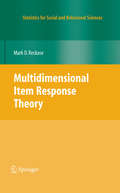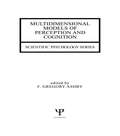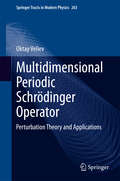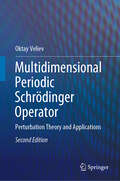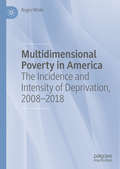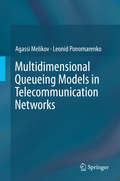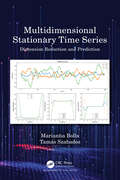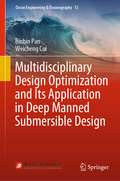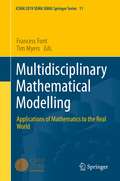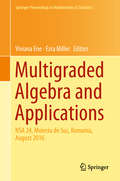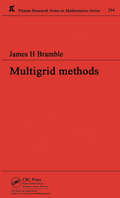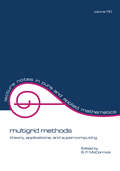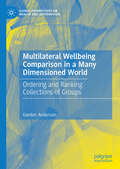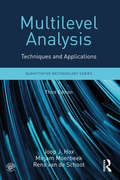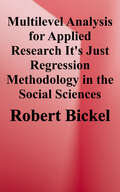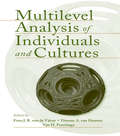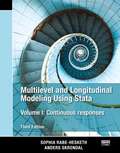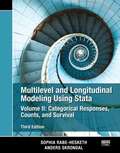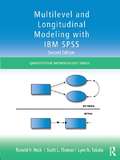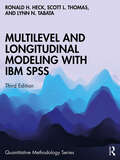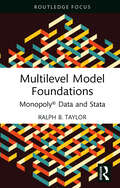- Table View
- List View
Multidimensional Item Response Theory
by M. D. ReckaseFirst thorough treatment of multidimensional item response theory Description of methods is supported by numerous practical examples Describes procedures for multidimensional computerized adaptive testing
Multidimensional Models of Perception and Cognition (Scientific Psychology Series)
by F. Gregory AshbyThe mental representations of perceptual and cognitive stimuli vary on many dimensions. In addition, because of quantal fluctuations in the stimulus, spontaneous neural activity, and fluctuations in arousal and attentiveness, mental events are characterized by an inherent variability. During the last several years, a number of models and theories have been developed that explicitly assume the appropriate mental representation is both multidimensional and probabilistic. This new approach has the potential to revolutionize the study of perception and cognition in the same way that signal detection theory revolutionized the study of psychophysics. This unique volume is the first to critically survey this important new area of research.
Multidimensional Periodic Schrödinger Operator
by Oktay VelievThe book describes the direct problems and the inverse problem of the multidimensional Schrödinger operator with a periodic potential. This concerns perturbation theory and constructive determination of the spectral invariants and finding the periodic potential from the given Bloch eigenvalues. The unique method of this book derives the asymptotic formulas for Bloch eigenvalues and Bloch functions for arbitrary dimension. Moreover, the measure of the iso-energetic surfaces in the high energy region is construct and estimated. It implies the validity of the Bethe-Sommerfeld conjecture for arbitrary dimensions and arbitrary lattices. Using the perturbation theory constructed in this book, the spectral invariants of the multidimensional operator from the given Bloch eigenvalues are determined. Some of these invariants are explicitly expressed by the Fourier coefficients of the potential. This way the possibility to determine the potential constructively by using Bloch eigenvalues as input data is given. In the end an algorithm for the unique determination of the potential is given.
Multidimensional Periodic Schrödinger Operator: Perturbation Theory and Applications
by Oktay VelievThis book describes the direct and inverse problems of the multidimensional Schrödinger operator with a periodic potential, a topic that is especially important in perturbation theory, constructive determination of spectral invariants and finding the periodic potential from the given Bloch eigenvalues. It provides a detailed derivation of the asymptotic formulas for Bloch eigenvalues and Bloch functions in arbitrary dimensions while constructing and estimating the measure of the iso-energetic surfaces in the high-energy regime. Moreover, it presents a unique method proving the validity of the Bethe–Sommerfeld conjecture for arbitrary dimensions and arbitrary lattices. Using the perturbation theory constructed, it determines the spectral invariants of the multidimensional operator from the given Bloch eigenvalues. Some of these invariants are explicitly expressed by the Fourier coefficients of the potential, making it possible to determine the potential constructively using Bloch eigenvalues as input data. Lastly, the book presents an algorithm for the unique determination of the potential. This updated second edition includes an additional chapter that specifically focuses on lower-dimensional cases, providing the basis for the higher-dimensional considerations of the chapters that follow.
Multidimensional Periodic Schrödinger Operator: Perturbation Theories for High Energy Regions and Their Applications (Springer Tracts in Modern Physics #291)
by Oktay VelievThis book describes the direct and inverse problems of the multidimensional Schrödinger operator with a periodic potential, a topic that is especially important in perturbation theory, constructive determination of spectral invariants and finding the periodic potential from the given Bloch eigenvalues. It provides a detailed derivation of the asymptotic formulas for Bloch eigenvalues and Bloch functions in arbitrary dimensions while constructing and estimating the measure of the iso-energetic surfaces in the high-energy regime. Moreover, it presents a unique method proving the validity of the Bethe–Sommerfeld conjecture for arbitrary dimensions and arbitrary lattices. Using the perturbation theory constructed, it determines the spectral invariants of the multidimensional operator from the given Bloch eigenvalues. Some of these invariants are explicitly expressed by the Fourier coefficients of the potential, making it possible to determine the potential constructively using Bloch eigenvalues as input data. Lastly, the book presents an algorithm for the unique determination of the potential.This updated and significantly expanded third edition features an extension of this framework to all dimensions, offering a now complete theory of self-adjoint Schrödinger operators within periodic potentials. Drawing from recent advancements in mathematical analysis, this edition delves even deeper into the intricacies of the subject. It explores the connections between the multidimensional Schrödinger operator, periodic potentials, and other fundamental areas of mathematical physics. The book's comprehensive approach equips both students and researchers with the tools to tackle complex problems and contribute to the ongoing exploration of quantum phenomena.
Multidimensional Poverty in America: The Incidence and Intensity of Deprivation, 2008-2018
by Roger WhiteThis book investigates and documents multidimensional poverty in the United States and identifies patterns and relationships that contribute to the development of a more complete understanding of the incidence and intensity of deprivation. The first part introduces multidimensional poverty and provides a rationale for viewing poverty through a lens of multiple deprivations. It discusses how the Multidimensional Poverty Index (MPI) compares to more narrowly-focused, income-based poverty measures and emphasizes its usefulness and applicability for the formulation of related, welfare-enhancing public policies. The second part documents multidimensional poverty incidence, intensity, and corresponding MPI values at the aggregate level of detail, for various demographic cohorts, and across geographic locales. The book then presents results from an empirical analysis that identifies the determinants of multidimensional poverty incidence and of individual deprivation scores. The third part consists of three studies of multidimensional poverty, examining the effect of the Affordable Care Act on multidimensional poverty incidence and intensity, variation in multidimensional poverty across native- and foreign-born residents (and across immigrants’ home countries) of the US, and variation in the respective indicators that contribute to multidimensional poverty across the life cycle. The book closes with two chapters. The first relays the findings of counterfactual exercises where certain deprivations are assumed to have been eliminated. The final chapter summarizes the work, draws inferences and arrives at conclusions, and discusses the corresponding public policy implications.
Multidimensional Queueing Models in Telecommunication Networks
by Agassi Melikov Leonid PonomarenkoThe increasing complexity of telecommunication networks requires us to develop adequate mathematical models. We must find their characteristics, optimize them subject to chosen criteria, and develop the corresponding control algorithms. Multidimensional queueing models are used to design and optimize modern and next-generation networks (NGN). The central problem of the related mathematical theory is to apply multidimensional and large-size queueing models to improve efficiency. In this book new methods are successively developed and applied to solve related problems. The book is recommended for researchers engaged with the mathematical theory of telecommunications traffic.
Multidimensional Stationary Time Series: Dimension Reduction and Prediction
by Marianna Bolla Tamás SzabadosThis book gives a brief survey of the theory of multidimensional (multivariate), weakly stationary time series, with emphasis on dimension reduction and prediction. Understanding the covered material requires a certain mathematical maturity, a degree of knowledge in probability theory, linear algebra, and also in real, complex and functional analysis. For this, the cited literature and the Appendix contain all necessary material. The main tools of the book include harmonic analysis, some abstract algebra, and state space methods: linear time-invariant filters, factorization of rational spectral densities, and methods that reduce the rank of the spectral density matrix. Serves to find analogies between classical results (Cramer, Wold, Kolmogorov, Wiener, Kálmán, Rozanov) and up-to-date methods for dimension reduction in multidimensional time series Provides a unified treatment for time and frequency domain inferences by using machinery of complex and harmonic analysis, spectral and Smith--McMillan decompositions. Establishes analogies between the time and frequency domain notions and calculations Discusses the Wold's decomposition and the Kolmogorov's classification together, by distinguishing between different types of singularities. Understanding the remote past helps us to characterize the ideal situation where there is a regular part at present. Examples and constructions are also given Establishes a common outline structure for the state space models, prediction, and innovation algorithms with unified notions and principles, which is applicable to real-life high frequency time series It is an ideal companion for graduate students studying the theory of multivariate time series and researchers working in this field.
A Multidisciplinary Approach to Capability in Age and Ageing (International Perspectives on Aging #31)
by Hanna Falk Erhag Ulrika Lagerlöf Nilsson Therese Rydberg Sterner Ingmar SkoogThis open access book provides insight on how to interpret capability in ageing – one’s individual ability to perform actions in order to reach goals one has reason to value – from a multidisciplinary approach. With for the first time in history there being more people in the world aged 60 years and over than there are children below the age of 5, the book describes this demographic trends as well as the large global challenges and important societal implications this will have such as a worldwide increase in the number of persons affected with dementia, and in the ratio of retired persons to those still in the labor market. Through contributions from many different research areas, it discussed how capability depends on interactions between the individual (e.g. health, genetics, personality, intellectual capacity), environment (e.g. family, friends, home, work place), and society (e.g. political decisions, ageism, historical period). The final chapter summarizes the differences and similarities in these contributions. As such this book provides an interesting read for students, teachers and researchers at different levels and from different fields interested in capability and multidisciplinary research.
Multidisciplinary Design Optimization and Its Application in Deep Manned Submersible Design (Ocean Engineering & Oceanography #13)
by Binbin Pan Weicheng CuiThis book investigates Reliability-based Multidisciplinary Design Optimization (RBMDO) theory and its application in the design of deep manned submersibles (DMSs). Multidisciplinary Design Optimization (MDO) is an effective design method for large engineering systems like aircraft, warships, and satellites, which require designers and engineers from various disciplines to cooperate with each other. MDO can be used to handle the conflicts that arise between these disciplines, and focuses on the optimal design of the system as a whole. However, it can also push designs to the brink of failure. In order to keep the system balanced, Reliability-based Design (RBD) must be incorporated into MDO. Consequently, new algorithms and methods have to be developed for RBMDO theory.This book provides an essential overview of MDO, RBD, and RBMDO and subsequently introduces key algorithms and methods by means of case analyses. In closing, it introduces readers to the design of DMSs and applies RBMDO methods to the design of the manned hull and the general concept design. The book is intended for all students and researchers who are interested in system design theory, and for engineers working on large, complex engineering systems.
Multidisciplinary Mathematical Modelling: Applications of Mathematics to the Real World (SEMA SIMAI Springer Series #11)
by Francesc Font Tim G. MyersThis book presents a selection of the talks resulting from research carried out by different groups at the Centre de Recerca Matemàtica and presented at the International Congress on Industrial and Applied Mathematics, held in Valencia in 2019. The various chapters describe a wide variety of topics: cancer modelling, carbon capture by adsorption, nanoscale diffusion and complex systems to predict earthquakes. These mathematical studies were specifically aided via collaborations with biomedical engineers, physicists and chemists. The book is addressed to researchers in all of these areas as well as in general mathematical modelling.
Multifractal Financial Markets
by Yasmine Hayek KobeissiMultifractal Financial Markets explores appropriate models for estimating risk and profiting from market swings, allowing readers to develop enhanced portfolio management skills and strategies. Fractals in finance allow us to understand market instability and persistence. When applied to financial markets, these models produce the requisite amount of data necessary for gauging market risk in order to mitigate loss. This brief delves deep into the multifractal market approach to portfolio management through real-world examples and case studies, providing readers with the tools they need to forecast profound shifts in market activity.
Multigraded Algebra and Applications: NSA 24, Moieciu de Sus, Romania, Аugust 2016 (Springer Proceedings in Mathematics & Statistics #238)
by Viviana Ene Ezra MillerThis volume contains research papers and surveys reflecting the topics discussed at the EMS Summer School on Multigraded Algebra and Applications held in Romania in August 2016. The school, which served as the 24th National School on Algebra, presented the main research directions of combinatorial commutative algebra with a strong focus on its applications in combinatorics, statistics, and biology. Recent progress in the field has led to new insights and suggested algebraic techniques for solving real-world data analysis problems. The summer school and resulting proceedings volume have raised numerous novel questions and encouraged a more interdisciplinary approach for young researchers when considering problems in pure and applied mathematical research.Featured topics in this volume include toric rings, binomial edge ideals, Betti numbers for numerical semigroup rings, and Waldschmidt constants. Researchers and graduate students interested in the developments of the field will find this book useful for their studies.
Multigrid Methods (Chapman And Hall/crc Research Notes In Mathematics Ser. #294)
by James H BrambleMultigrid methods are among the most efficient iterative methods for the solution of linear systems which arise in many large scale scientific calculations. Every researcher working with the numerical solution of partial differential equations should at least be familiar with this powerful technique. This invaluable book presents results concerning the rates of convergence of multigrid iterations.
multigrid methods: theory, applications, and supercomputing
by Stephen F. MccormickThis book is a collection of research papers on a wide variety of multigrid topics, including applications, computation and theory. It represents proceedings of the Third Copper Mountain Conference on Multigrid Methods, which was held at Copper Mountain, Colorado.
Multilateral Wellbeing Comparison in a Many Dimensioned World: Ordering and Ranking Collections of Groups (Global Perspectives on Wealth and Distribution)
by Gordon AndersonThis book addresses the disparities that arise when measuring and modeling societal behavior and progress across the social sciences. It looks at why and how different disciplines and even researchers can use the same data and yet come to different conclusions about equality of opportunity, economic and social mobility, poverty and polarization, and conflict and segregation. Because societal behavior and progress exist only in the context of other key aspects, modeling becomes exponentially more complex as more of these aspects are factored into considerations. The content of this book transcends disciplinary boundaries, providing valuable information on measuring and modeling to economists, sociologists, and political scientists who are interested in data-based analysis of pressing social issues.
Multilevel Analysis: Techniques and Applications, Third Edition (Quantitative Methodology Series )
by Joop J. Hox Mirjam Moerbeek Rens van de SchootApplauded for its clarity, this accessible introduction helps readers apply multilevel techniques to their research. The book also includes advanced extensions, making it useful as both an introduction for students and as a reference for researchers. Basic models and examples are discussed in nontechnical terms with an emphasis on understanding the methodological and statistical issues involved in using these models. The estimation and interpretation of multilevel models is demonstrated using realistic examples from various disciplines including psychology, education, public health, and sociology. Readers are introduced to a general framework on multilevel modeling which covers both observed and latent variables in the same model, while most other books focus on observed variables. In addition, Bayesian estimation is introduced and applied using accessible software.
Multilevel Analysis: Techniques and Applications, Second Edition
by Joop J. Hox Rens van de Schoot Mirjam MoerbeekThis practical introduction helps readers apply multilevel techniques to their research. Noted as an accessible introduction, the book also includes advanced extensions, making it useful as both an introduction and as a reference to students, researchers, and methodologists. Basic models and examples are discussed in non-technical terms with an emphasis on understanding the methodological and statistical issues involved in using these models. The estimation and interpretation of multilevel models is demonstrated using realistic examples from various disciplines. For example, readers will find data sets on stress in hospitals, GPA scores, survey responses, street safety, epilepsy, divorce, and sociometric scores, to name a few. The data sets are available on the website in SPSS, HLM, MLwiN, LISREL and/or Mplus files. Readers are introduced to both the multilevel regression model and multilevel structural models. Highlights of the second edition include: Two new chapters--one on multilevel models for ordinal and count data (Ch. 7) and another on multilevel survival analysis (Ch. 8). Thoroughly updated chapters on multilevel structural equation modeling that reflect the enormous technical progress of the last few years. The addition of some simpler examples to help the novice, whilst the more complex examples that combine more than one problem have been retained. A new section on multivariate meta-analysis (Ch. 11). Expanded discussions of covariance structures across time and analyzing longitudinal data where no trend is expected. Expanded chapter on the logistic model for dichotomous data and proportions with new estimation methods. An updated website at http://www.joophox.net/ with data sets for all the text examples and up-to-date screen shots and PowerPoint slides for instructors. Ideal for introductory courses on multilevel modeling and/or ones that introduce this topic in some detail taught in a variety of disciplines including: psychology, education, sociology, the health sciences, and business. The advanced extensions also make this a favorite resource for researchers and methodologists in these disciplines. A basic understanding of ANOVA and multiple regression is assumed. The section on multilevel structural equation models assumes a basic understanding of SEM.
Multilevel Analysis for Applied Research: It's Just Regression!
by Robert BickelThis book provides a uniquely accessible introduction to multilevel modeling, a powerful tool for analyzing relationships between an individual-level dependent variable, such as student reading achievement, and individual-level and contextual explanatory factors, such as gender and neighborhood quality. <p><p>Helping readers build on the statistical techniques they already know, Robert Bickel emphasizes the parallels with more familiar regression models, shows how to do multilevel modeling using SPSS, and demonstrates how to interpret the results. He discusses the strengths and limitations of multilevel analysis and explains specific circumstances in which it offers (or does not offer) methodological advantages over more traditional techniques. Over 300 dataset examples from research on educational achievement, income attainment, voting behavior, and other timely issues are presented in numbered procedural steps.
Multilevel Analysis of Individuals and Cultures
by Fons J.R. van de Vijver Dianne A. Van Hemert Ype H. PoortingaIn this book, top specialists address theoretical, methodological, and empirical multilevel models as they relate to the analysis of individual and cultural data. Divided into four parts, the book opens with the basic conceptual and theoretical issues in multilevel research, including the fallacies of such research. Part II describes the methodological aspects of multilevel research, including data-analytic and structural equation modeling techniques. Applications and models from various research areas including control, values, organizational behavior, social beliefs, well-being, personality, response styles, school performance, family, and acculturation, are explored in Part III. This section also deals with validity issues in aggregation models. The book concludes with an overview of the kinds of questions addressed in multilevel models and highlights the theoretical and methodological issues yet to be explored. This book is intended for researchers and advanced students in psychology, sociology, social work, marriage and family therapy, public health, anthropology, education, economics, political science, and cultural and ethnic studies who study the relationship between behavior and culture.
Multilevel And Longitudinal Modeling Using Stata,
by Sophia Rabe-Hesketh Anders SkrondalVolume I is devoted to continuous Gaussian linear mixed models and has nine chapters. The chapters are organized in four parts. The first part provides a review of the methods of linear regression. The second part provides an in-depth coverage of the two-level models, the simplest extensions of a linear regression model. <P><P>The mixed-model foundation and the in-depth coverage of the mixed-model principles provided in volume I for continuous outcomes, make it straightforward to transition to generalized linear mixed models for noncontinuous outcomes described in volume II.
Multilevel And Longitudinal Modeling Using Stata, Third Edition (volume Ii)
by Sophia Rabe-Hesketh Anders SkrondalVolume II is devoted to generalized linear mixed models for binary, categorical, count, and survival outcomes. The second volume has seven chapters also organized in four parts. The first three parts in volume II cover models for categorical responses, including binary, ordinal, and nominal (a new chapter); models for count data; and models for survival data, including discrete-time and continuous-time (a new chapter) survival responses. The final part in volume II describes models with nested and crossed-random effects with an emphasis on binary outcomes.
Multilevel and Longitudinal Modeling with IBM SPSS: Multilevel And Longitudinal Modeling With Ibm Spss (Quantitative Methodology Series)
by Ronald H. Heck Scott L. Thomas Lynn N. TabataThis book demonstrates how to use multilevel and longitudinal modeling techniques available in the IBM SPSS mixed-effects program (MIXED). Annotated screen shots provide readers with a step-by-step understanding of each technique and navigating the program. Readers learn how to set up, run, and interpret a variety of models. Diagnostic tools, data management issues, and related graphics are introduced throughout. Annotated syntax is also available for those who prefer this approach. Extended examples illustrate the logic of model development to show readers the rationale of the research questions and the steps around which the analyses are structured. The data used in the text and syntax examples are available at www.routledge.com/9780415817110. Highlights of the new edition include: Updated throughout to reflect IBM SPSS Version 21. Further coverage of growth trajectories, coding time-related variables, covariance structures, individual change and longitudinal experimental designs (Ch.5). Extended discussion of other types of research designs for examining change (e.g., regression discontinuity, quasi-experimental) over time (Ch.6). New examples specifying multiple latent constructs and parallel growth processes (Ch. 7). Discussion of alternatives for dealing with missing data and the use of sample weights within multilevel data structures (Ch.1). The book opens with the conceptual and methodological issues associated with multilevel and longitudinal modeling, followed by a discussion of SPSS data management techniques which facilitate working with multilevel, longitudinal, and cross-classified data sets. Chapters 3 and 4 introduce the basics of multilevel modeling: developing a multilevel model, interpreting output, and trouble-shooting common programming and modeling problems. Models for investigating individual and organizational change are presented in chapters 5 and 6, followed by models with multivariate outcomes in chapter 7. Chapter 8 provides an illustration of multilevel models with cross-classified data structures. The book concludes with ways to expand on the various multilevel and longitudinal modeling techniques and issues when conducting multilevel analyses. Ideal as a supplementary text for graduate courses on multilevel and longitudinal modeling, multivariate statistics, and research design taught in education, psychology, business, and sociology, this book’s practical approach also appeals to researchers in these fields. The book provides an excellent supplement to Heck & Thomas’s An Introduction to Multilevel Modeling Techniques, 2nd Edition; however, it can also be used with any multilevel and/or longitudinal modeling book or as a stand-alone text.
Multilevel and Longitudinal Modeling with IBM SPSS (Quantitative Methodology Series)
by Ronald H. Heck Scott L. Thomas Lynn N. TabataMultilevel and Longitudinal Modeling with IBM SPSS, Third Edition, demonstrates how to use the multilevel and longitudinal modeling techniques available in IBM SPSS Versions 25-27. Annotated screenshots with all relevant output provide readers with a step-by-step understanding of each technique as they are shown how to navigate the program. Throughout, diagnostic tools, data management issues, and related graphics are introduced. SPSS commands show the flow of the menu structure and how to facilitate model building, while annotated syntax is also available for those who prefer this approach. Extended examples illustrating the logic of model development and evaluation are included throughout the book, demonstrating the context and rationale of the research questions and the steps around which the analyses are structured. The book opens with the conceptual and methodological issues associated with multilevel and longitudinal modeling, followed by a discussion of SPSS data management techniques that facilitate working with multilevel, longitudinal, or cross-classified data sets. The next few chapters introduce the basics of multilevel modeling, developing a multilevel model, extensions of the basic two-level model (e.g., three-level models, models for binary and ordinal outcomes), and troubleshooting techniques for everyday-use programming and modeling problems along with potential solutions. Models for investigating individual and organizational change are next developed, followed by models with multivariate outcomes and, finally, models with cross-classified and multiple membership data structures. The book concludes with thoughts about ways to expand on the various multilevel and longitudinal modeling techniques introduced and issues (e.g., missing data, sample weights) to keep in mind in conducting multilevel analyses. Key features of the third edition: Thoroughly updated throughout to reflect IBM SPSS Versions 26-27. Introduction to fixed-effects regression for examining change over time where random-effects modeling may not be an optimal choice. Additional treatment of key topics specifically aligned with multilevel modeling (e.g., models with binary and ordinal outcomes). Expanded coverage of models with cross-classified and multiple membership data structures. Added discussion on model checking for improvement (e.g., examining residuals, locating outliers). Further discussion of alternatives for dealing with missing data and the use of sample weights within multilevel data structures. Supported by online data sets, the book's practical approach makes it an essential text for graduate-level courses on multilevel, longitudinal, latent variable modeling, multivariate statistics, or advanced quantitative techniques taught in departments of business, education, health, psychology, and sociology. The book will also prove appealing to researchers in these fields. The book is designed to provide an excellent supplement to Heck and Thomas's An Introduction to Multilevel Modeling Techniques, Fourth Edition; however, it can also be used with any multilevel or longitudinal modeling book or as a stand-alone text.
Multilevel Model Foundations: Monopoly® Data and Stata
by Ralph B. TaylorThis book introduces the foundations of multilevel models, using Monopoly® rent data, from the classic board game, and the statistical program Stata®. Widespread experience with the game means many readers have a head start on understanding these models. The small-data set, 132 rent values for 22 properties clustered by the four sides of the playing board, combines with extensive graphical displays of data and results so all readers can see core multilevel ideas in action at a granular level. Two chapters on standard statistical models, one-way analysis of variance and multiple regression, help readers see how multilevel models rely on but also extend these monolevel ideas. Chapters present three basic multilevel models for cross-sectional analyses – analysis of variance, analysis of covariance, and random coefficients regression – and one basic developmental model for longitudinal analyses. Troubleshooting guidance, combined with close examination of data patterns, and careful inspection of model parameters, all help readers better grasp what model results mean, when model results should or should not be trusted, and how model results link back to core theoretical questions. Consequently, readers will develop a sense of best practices for building and diagnosing their own multilevel models. Those who complete the volume can readily apply what they have learned to more complex datasets and models and adapt available online Stata do files to those projects. Any social scientist working with data clustered in time, in space, or in both, and seeking to learn more about how to use, interpret, or teach these models, will find the book useful.
